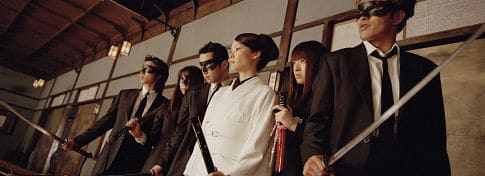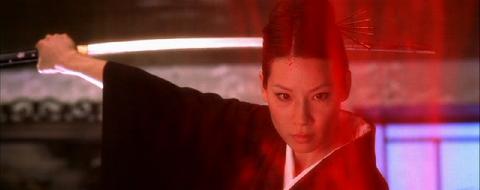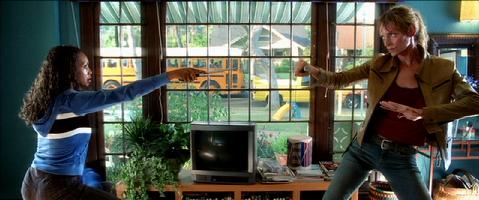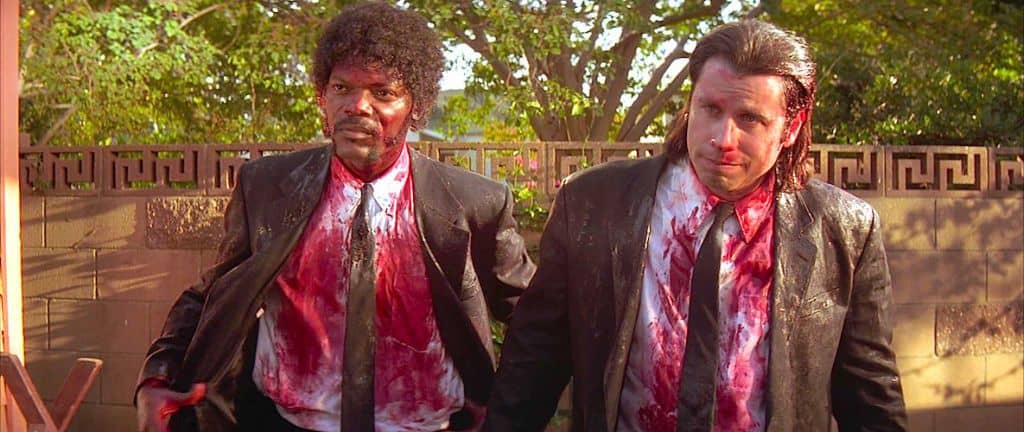My name is Rob Carr. I attend a small college in Manchester, NH where I just completed my first course in the art of film. Attached below is my “thesis” for this class. To make a long story short, on the first day of class my professor used the word gratuitous and said an example of gratuitous violence would be Tarantino’s “Kill Bill”. I disagreed and decided to prove that the violence in QT’s film was warranted with my thesis, entitled “Why Violence Must Be Used to Kill Bill.”
Quentin Tarantino’s “Kill Bill: Vol. 1” opens with violence. It also ends in violence. And the middle is, for the most part, full of violence, too. The story line goes as follows: a pregnant bride-to-be wakes up from a four-year coma to realize that her former partners in assassination have massacred the wedding party, so she vows to get even. Some film critics have said that the violence with which the Bride goes about exacting her revenge is gratuitous, but that is only because they do not understand the length Tarantino goes to ensure that the violence is just the opposite. He uses different cinematographic techniques, creates a sense of irony, forms characters, and instils his own stylized violence as a way of masking violence not directly pertaining to the plot. All the violence in Tarantino’s movie is functional. It serves to advance the plot and the film’s main theme: revenge and the effects on the avenger.
Tarantino has two major influences that are relived through his works: spaghetti westerns and kung-fu classics. Taken from directors like Sergio Leone, Tarantino uses the idea of the anti-hero protagonist. The anti-hero acts usually on selfish desires and in ways that society sees as ethically in the wrong (or at least in opposition to how a true hero should act). In spaghetti westerns of the mid 20th century, the heart of the film’s plot often relied on the effect this flaw of character had on the anti-hero.
The Bride in Kill Bill is so much related to the anti-hero of Leone’s films that it would be folly to reject the idea that Tarantino did not want his viewers to experience the same effect in his film. (It’s probably not a coincidence that the massacre, which represents the birth of the motive in Kill Bill, takes place in the American desert, also the setting of westerns.) The style of combat and the weapons used in “Kill Bill” quite obviously are taken from the kung-fu movie genre. In fact, it could be said that Tarantino’s film is simply a modern-day western that replaces guns with samurai swords, deserts with Japanese skyscrapers, and Indians with backstabbing assassins. It is from these influences that Tarantino gains a motive for the film’s violence and a violent style that he molds to make his own.
In order to fully understand the violence in “Kill Bill”, one must analyze not only the violence itself but the scenes preceding the violence. Before both major battles in the film, Tarantino quickly flashes three images. The first is a scene from the wedding massacre; it shows a blood-soaked bride being pummelled by her fellow assassins. The second flashing picture – also set at the wedding – is a close up of the target’s face. These first two flashes serve not only to place the Bride’s soon-to-be victims at the scene of the bloodbath wedding but also show their part in the Bride’s attempted murder. Other than sharing a setting, the first two shots have another cinematographic effect in common: they are filmed through a red lens.
The color red symbolizes two things. The first and most obvious is blood. It serves to symbolize not only the blood shed by the Bride at the hands of her former partners, but also to foreshadow the blood of the victims to be shed at the hands of the Bride. The second symbol that the red lens brings to the forefront is the Bride’s emotion during the flashback: rage and thus a need for revenge.
The third flash before the violent act comes in the present, and it too is a close-up of the antagonist’s face. This close up, immediately preceded by a close-up from the past, is a way of showing that, although four years have passed since the massacre, there is no forgetting and certainly no forgiving the crime they committed. Right before the Bride kills Copperhead, she says “We have unsettled business, and nothing you could’ve done in those four years can change that.”
The next step in the violent act committed by the Bride is an obvious result of her flashback and growing rage. In both the major fights of “Kill Bill: Vol. 1”, the Bride initiates the action with a quick, forceful, and violent attack. After Copperhead opens the door to her suburban home, the Bride throws her back inside with a kick to the chest. In the nightclub the Bride slices off the arm of one of O-Ren’s assistants, Sophie, who also had a role in the wedding massacre (Sophie’s own three-flash scene – two in a red lens past and the third in the present – comes a scene earlier when the two meet in the bathroom). The scenes preceding what are to be the two most violent scenes in Tarantino’s “Kill Bill” are his attempt to try to tell us something about the motive behind the Bride’s violence: these killings aren’t done for show. They are done as an act of revenge.
The music played during the flashback is also an important piece in Tarantino’s plan. The loud, screeching horns led by a fast-paced beat (similar to the famous sounds of Morricone found in spaghetti western films) are meant to intensify the feelings of the Bride and to warn the viewer of the impending action. This quick but complicated flashback scene is the director making a statement of approval for the use violence to exact the Bride’s revenge. It is Tarantino’s way of reminding the viewer of the story he has been telling throughout the narrative, and its placement – immediately preceding the Bride’s violence – is no accident.
The fight scenes in “Kill Bill: Vol. 1”, especially those with Copperhead, Cottonmouth, and the Crazy 88, are used by Tarantino to show the desperation of the Bride to exact her revenge. All these battles are excessively lengthy and the Bride always comes away from them wearing not only the blood of her victims but doused in her own blood as well. The Bride slices her way through all 88 members of O-ren’s gang in addition to her personal bodyguard before her battle with the Japanese crime boss. The emphasis on the blows she takes from her opponents and her condition afterwards is, combined with the detail that she always travels to meet her opponents, shows how far – both literally and figuratively – she is willing to go to kill the backstabbing assassins on her list.

Despite all the violence in his film, Tarantino does attempt to mask the graphicness of some of the scenes not pertaining directly to the Bride’s vengeance. He uses a Japanese-style anime cartoon when recounting the early life of O-Ren Ishii, possibly the most violent series of events in the whole film . Although the characteristic Tarantino blood fountain is still present in the cartoon, the director realizes that this graphic scene does not need to be shown in real-life because it does not advance the plot; it does not directly comment on the Bride’s revenge or emotional state as a result thereof.
Quentin Tarantino uses many other cinematic and plot techniques as an attempt to dull the necessary violence in his film. During the narrative Tarantino frequently flashes back to the wedding day massacre in black-and-white. “‘Black-and-white did make the movie go down easier’ with the motion picture association”, said Quentin in regards to the movie’s R rating. The black-and-white scenes, while reminding us that the action takes place in the past, show the viewer that it is not the actual violence, but rather the act of the massacre itself, for which the bride seeks her revenge.
Another peculiarity in the film can be used to comment on the Bride’s revenge. Throughout the film, Uma Thurman‘s character is hardly ever referred to by name. On the few occasions where her name is mentioned it is bleeped out; the audience simply knows her as “the Bride.” Tarantino doesn’t want us to know the Bride’s name. He doesn’t want us to know the real character, only her intentions. (This changes in “Vol. 2” when Tarantino reveals his characters as human beings and not just the sum of their motives, and thus the Bride’s name is revealed.) This small but compelling technique might be the biggest hint as to what the director really wants his audience to think about while watching “Kill Bill: Vol. 1”: the cause and effect of revenge, not so much the actual characters.

The amount of violence in “Kill Bill” is underscored because the style Tarantino brings to it creates a feeling of the fantastical. Victim’s blood comes spurting out of necks and torsos like water shoots up from the Bellagio fountains in Las Vegas (and with about just as much emphasis). But this style of killing only happens to minor characters like Boss Tanaka (after questioning O-Ren’s ancestry) and members of the Crazy 88, who had nothing to do with the wedding massacre. Copperhead and O-ren, the two members of the assassin team who the Bride crosses off her dead-list in “Vol. 1”, die real deaths. Their blood is not shot fountain-like into the air, it is simply spilled on the ground, their eyes widening and sinking deeper into their skulls, as the camera zooms and holds their dying face, a symbol of the anti-heroic victory for the Bride.
There is a lot of blood in “Kill Bill” but it’s all spilled with style, and all of it serves to advance the plot and the theme of revenge. Tarantino says that he used three different shades of blood throughout the film, each carrying its own implications. Film critic Tom Carson, speaking to the unparalleled amount of stylized violence and cinematic effects in “Kill Bill” says:
“…any film this into dousing audiences with not just blood but mood blood… owes more to “The Wizard of Oz” than to Peckinpah. It’s just that Uma Thurman as the Bride – Tarantino’s track-suited, sword-wielding answer to Dorothy – spends the movie hunting down and killing the Scarecrow, the Tin Man, and the Cowardly Lion for wronging her.”
Carson knows that Tarantino’s fourth film is more about the art and motive than the killings and bloodshed.

Tarantino also uses ironic settings in “Kill Bill: Vol 1” as a way to detract from the film’s necessary graphic violence. The first scene (the battle with Copperhead) is set in an upper class, suburban neighbourhood. The most ironic shot in “Kill Bill” comes during this fight. In the foreground the viewer sees two women, duelling with knives among a shattered coffee table and glass shelving, while in the background through a large bay window a school bus drops off a little girl who skips her way across the bring, sunny street into the home. The second fight is set in a Japanese nightclub with a young group of girls singing pop songs for a full dance floor. The irony produced by the setting and its impact on the violence shows that it is not the bloodshed but the motive behind it that is to be the focus of the film. Other settings, too, create an ironic effect that dulls the violence in the film. The sword-fight with O-Ren takes place in a snowy yard, where the bright red blood of O-Ren contrasts highly with the ground, signifying a victory for the Bride. And of course, there’s the flashback to how the story all began four years ago: a wedding massacre.
Another source that Tarantino makes use of is the use of women – both as protagonist and antagonist – in “Kill Bill”. “‘It just hurts more to see two women fighting… a fight between two guys… doesn’t have to be about the choreography. But if you take that and put in women, the more brutal they are to each other the more you wince’” , said Tarantino in an interview with The New York Times. Using women allows Tarantino to put more emphasis on the motive behind the fight scene than the fight scene itself and to create what Roger Ebert calls a “virtuoso celebration of fight choreography”
There is no denying that “Kill Bill: Vol. 1” is a violent film, but after analyzing the function of the violence there is also no denying that the violence is useful. Director Quentin Tarantino uses violence to show just how far the Bride will go to exact revenge on those who have wronged her. Tarantino knows that the violence is needed to advance the plot, and attempts to masks violence when it does not serve that purpose. When the violence serves a semi-effective role in the film, he creates a sense of unreality and irony which intensifies the emotions but covers the violence in the scene. The only times Tarantino uses real, graphic violence is to kill the major characters – those who had a role in the wedding massacre – because he knows these killings advance the theme of revenge. Kill Bill: Vol: 1 is a film that perfects the use of violence to advance the plot. As film critic Leonard Maltin wrote, Quentin Tarantino’s film is “operatically violent”


